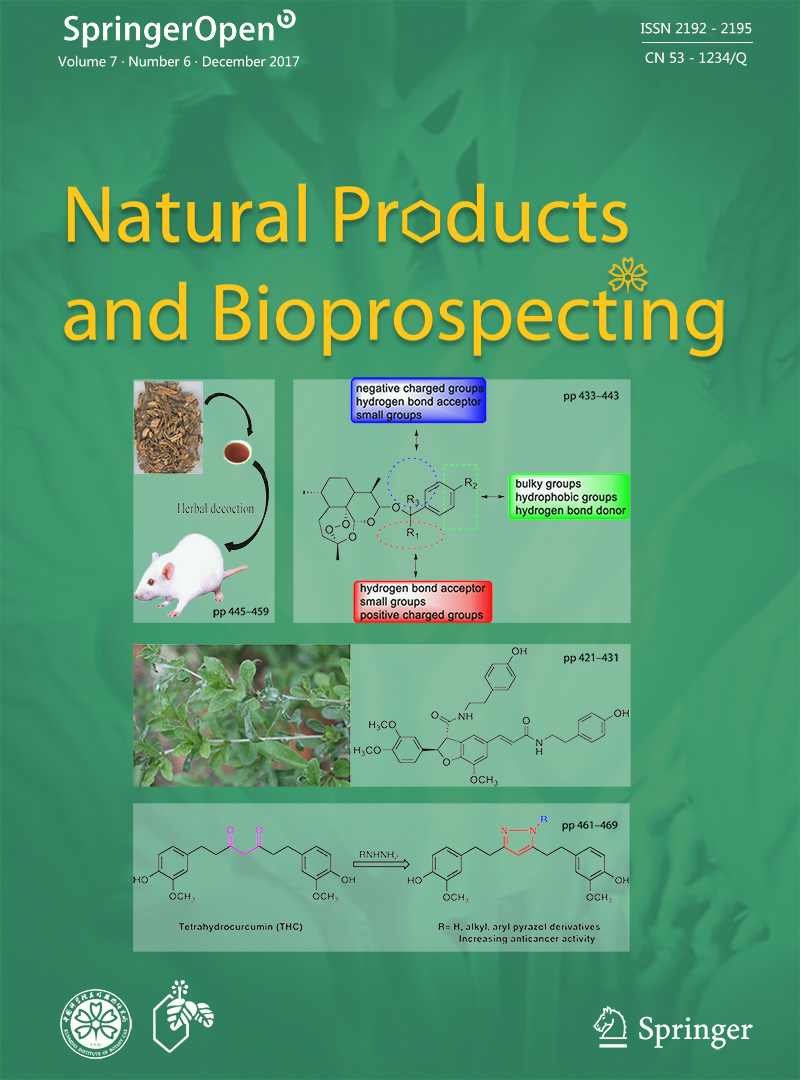|
|
The Anticancer Activities Phenolic Amides from the Stem of Lycium barbarum
Collect
Pei-Feng Zhu, Zhi Dai, Bei Wang, Xin Wei, Hao-Fei Yu, Zi-Ru Yan, Xu-Dong Zhao, Ya-Ping Liu, Xiao-Dong Luo
Natural Products and Bioprospecting. 2017, 7 (6): 421-431.
DOI: 10.1007/s13659-017-0134-x
Four new phenolic amides, 4-O-methylgrossamide (1), (E)-2-(4,5-dihydroxy-2-{3-[(4-hydroxyphenethyl)amino]-3-oxopropyl}-phenyl)-3-(4-hydroxy-3-methoxyphenyl)-N-(4-hydroxyphenethyl)acryl-amide (2), (Z)-lyciumamide C (3), (Z)-thoreliamide B (4), together with thirteen known phenolic amides were identified from the stem of Lycium barbarum. The structures of the new compounds were determined by spectroscopic methods. All compounds were evaluated for their anti-cancer activities against human glioma stem cell lines.
References |
Related Articles |
Metrics
|
|
|
Computational Analysis of Artimisinin Derivatives on the Antitumor Activities
Collect
Hui Liu, Xingyong Liu, Li Zhang
Natural Products and Bioprospecting. 2017, 7 (6): 433-443.
DOI: 10.1007/s13659-017-0142-x
The study on antitumor activities of artemisinin and its derivatives has been closely focused on in recent years. Herein, 2D and 3D QSAR analysis was performed on the basis of a series of artemisinin derivatives with known bioactivities against the non-small-cell lung adenocarcinoma A549 cells. Four QSAR models were successfully established by CoMSIA, CoMFA, topomer CoMFA and HQSAR approaches with respective characteristic values q2=0.567, R2=0.968, ONC=5; q2=0.547, R2=0.980, ONC=7; q2=0.559, R2=0.921, ONC=7 and q2=0.527, R2=0.921, ONC=6. The predictive ability of CoMSIA with r2=0.991 is the best one compared with the other three approaches, such as CoMFA (r2=0.787), topomer CoMFA (r2=0.819) and HQSAR (r2=0.743). The final QSAR models can provide guidance in structural modification of artemisinin derivatives to improve their anticancer activities.
References |
Related Articles |
Metrics
|
|
|
Pharmacokinetic Analysis of Four Bioactive Iridoid and Secoiridoid Glycoside Components of Radix Gentianae Macrophyllae and Their Synergistic Excretion by HPLC-DAD Combined with Second-Order Calibration
Collect
Tian-Ming Yang, Yang-Xi Liu, Hai-Yan Fu, Wei Lan, Han-Bo Su, He-Bin Tang, Qiao-Bo Yin, He-Dong Li, Li-Ping Wang, Hai-Long Wu
Natural Products and Bioprospecting. 2017, 7 (6): 445-459.
DOI: 10.1007/s13659-017-0145-7
An HPLC-DAD method combined with second-order calibration based on the alternating trilinear decomposition (ATLD) algorithm with the aid of region selection was developed to simultaneously and quantitatively characterize the synergistic relationships and cumulative excretion of the four bioactive ingredients of Radix Gentianae Macrophyllae in vivo. Although the analytes spectra substantially overlapped with that of the biological matrix, the overlapping profiles between analytes and co-eluting interferences can be successfully separated and accurately quantified by the ATLD method on the basis of the strength of region selection. The proposed approach not only determined the content change but also revealed the synergistic relationships and the cumulative excretion in vivo of the four ingredients in urine and feces samples collected at different excretion time intervals. In addition, several statistical parameters were employed to evaluate the accuracy and precision of the method. Quantitative results were confirmed by HPLC-mass spectrometry. Satisfactory results indicated that the proposed approach can be utilized to investigate the pharmacokinetics of Radix Gentianae Macrophyllae excretion in vivo.
References |
Related Articles |
Metrics
|
|
|
Synthesis and Cytotoxic Activity of Novel Tetrahydrocurcumin Derivatives Bearing Pyrazole Moiety
Collect
Ahmed Mahal, Ping Wu, Zi-Hua Jiang, Xiaoyi Wei
Natural Products and Bioprospecting. 2017, 7 (6): 461-469.
DOI: 10.1007/s13659-017-0143-9
Tetrahydrocurcumin (THC) is a major metabolite of curcumin and plays an important role in curcumin-induced biological effects. THC is a promising preventive and chemotherapeutic agent for cancer. A series of new pyrazole derivatives of THC have been synthesized as potent anticancer agents. Direct condensation of THC with various substituted hydrazines leads to new pyrazole derivatives of THC (1-18). The prepared compounds have been evaluated via in vitro MTT (3-(4,5-dimethylthiazol-2-yl)-2,5-diphenyltetrazolium bromide) assay for their cell proliferation-inhibitory activity against human lung adenocarcinoma (A549), human cervical carcinoma (HeLa) and human breast carcinoma (MCF-7) cells. Most derivatives show significantly higher anticancer activity against all three tested cancer cell lines than the parent compound THC. Several compounds (7, 8, 12, 13 and 15) display promising anticancer activity against MCF-7 cell line with IC50 values ranging from 5.8 to 9.3 μM. The most active compound (8) is substituted with 4-bromophenyl group at the pyrazole ring and inhibits the growth of all three tested cancer cell lines with an IC50 values of (8.0 μM, A549), (9.8 μM, HeLa) and (5.8 μM, MCF-7). The obtained compounds can be a good starting point for the development of new lead molecules in the fight against cancer.
References |
Related Articles |
Metrics
|
|

